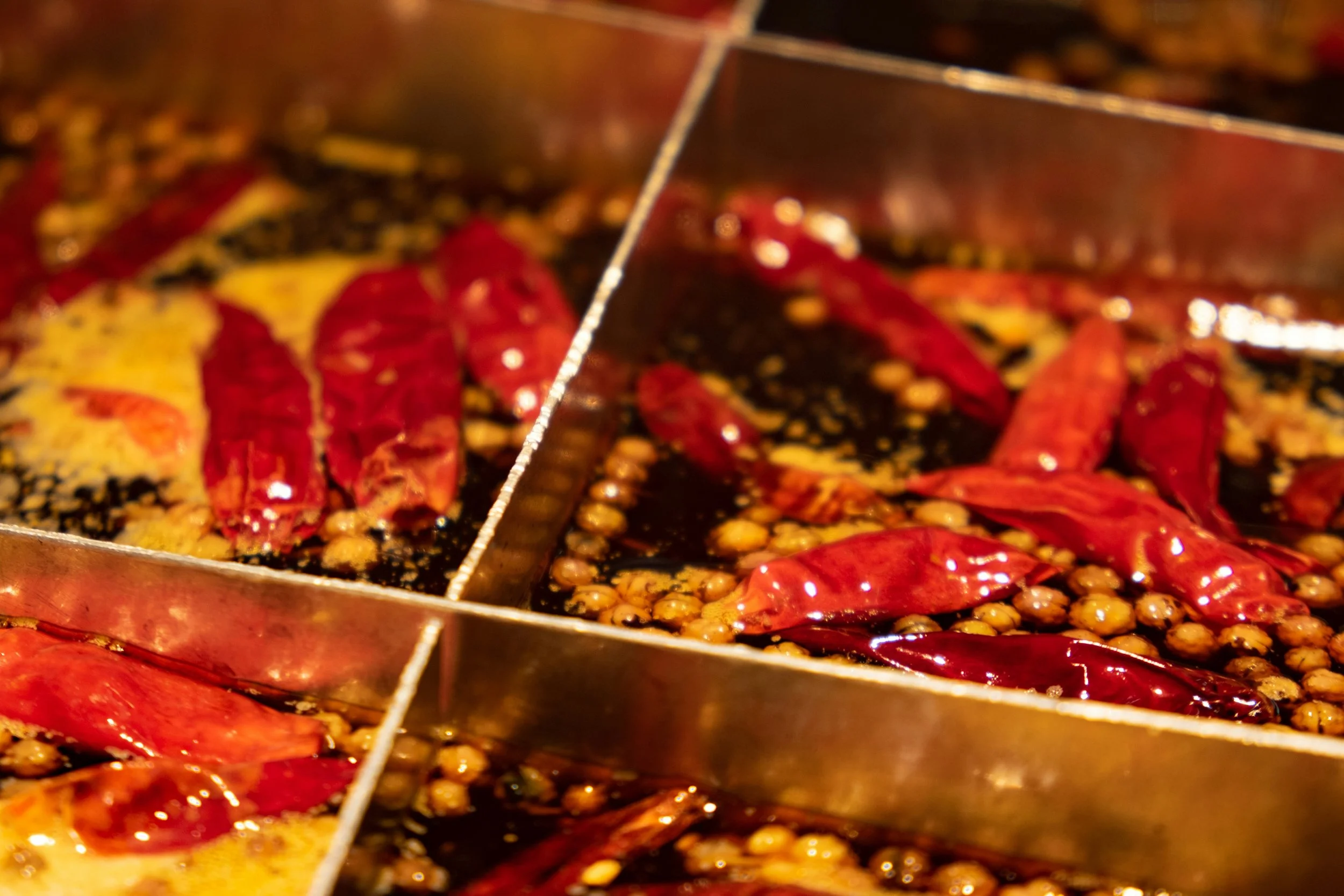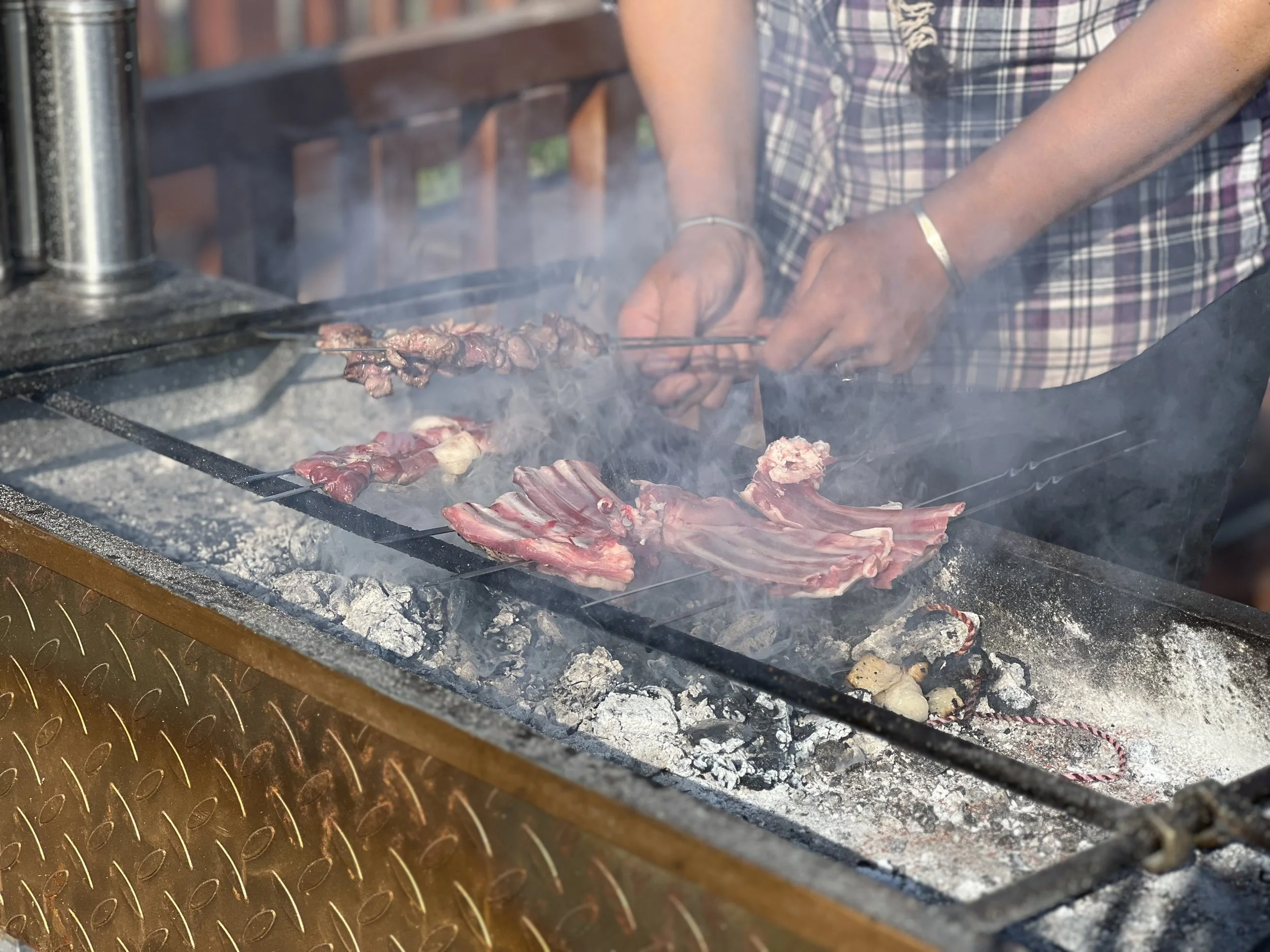Huǒ |火 | Fire
Cooking Meat in Northern China
In their essay Modern China: South Anderson and Anderson discuss an unconscious approach to food in China that they call ‘minimax’. In cooking, this means maximising the flavour whilst minimising the amount of fuel used or ingredients needed. This whole philosophy carries over to a wide range of areas - agriculture, equipment, mise-en-place and many more. Chinese cooking needs only a few utensils and tools as many are multi-purpose. The wok, for instance, can be used to stir-fry, deep fry, shallow fry, braise and steam. Likewise, the cleaver is the only knife needed in the Chinese kitchen; compare this to the armoury of knives needed in a Western kitchen. The pantry is uncluttered too: rice can be used for breakfast, main course or desert.
Everything is examined with minimax philosophy in mind: how can I cook this in the simplest way but for maximum impact on the table? a chef might ask. When contemplating questions of cooking meat, the home cook with have two broad categories in mind: cooking with water or cooking with oil. A third category of ‘cold cooking’, or preserving, is still alive and well in Northern China too. None of these options would be the go-to method for a Western cook. We would likely opt for roasting if we were given a joint of beef or a whole chicken. However, roasted is rarely used in China at all. Most Chinese kitchens do not feature an oven at all. This can take a lot of getting used to for Western palettes as most of us have been conditioned to love the charred flavour of a topside or fore-rib. Slow-roasted hunks of meat are never found in Southern China, but the Northerners keep the Mongol spirit alive by cooking over fire now and again.
Cooked with Water
Cooking with water breaks down into six methods: boiling, steaming, marinating, braising, creating a soup, or ‘plunging’. The latter has taken modern China by storm in the form of hot pot. Ask anyone in China what their favourite food is and it’s likely they will say ‘hot pot’. Hot pot is an act of communal blanching: that is, dunking a cut of thinly sliced beef, lamb or vegetable into water (or oil) for 30 seconds or less, then dipping into a sauce. Dipping chopsticks of food into pots at the table is a national pastime in China. There’s a hot pot restaurant on almost every food street in every city, selling different styles from all across the country. There’s the simple Beijing style or the Northeast sauerkraut and pork hot pot, there’s the ever-popular spicy Chengdu pots or blow-your-head-off Chongqing style; there’s Guizhou sour hot pot, fragrant Yunnan chicken hot pots, Chaoshan beef hot pot and Cantonese seafood hot pots - the country is mad for hot pot in all forms. A big bubbling cauldron in the centre of the table is as close as we can get to sitting around a campfire in China. The spicy Chongqing hot pots are a kind of social bonding activity, a dangerous culinary sport of spice endurance with friends.
In the North, a traditional Beijing copper pot will shimmer in the centre of the table. It is a thing of beauty: a moat of water around a chimney at the centre and in the hollow base, flickering charcoals heating it all up. Beijing pots are filled with nothing except water. This infuriates some: there’s no spice, no oil, no flavour at all. But that’s the point. There’s no way to disguise inferior meat. Restaurants have to use the best lamb, cut thin enough to cook quickly, but thick enough to not fall apart in the water. Many Southerners still cannot understand this type of ancient and simplistic cooking.
Boiling lamb is common in Inner Mongolia, Ningxia, Gansu and Xinjiang and has been since pans were heated over flame. After millet, boiled mutton was probably the most important food. The Mongols of the Yuan loved fatty cuts and raised breeds of sheep such as the ‘fat-tailed sheep’ to give them what they wanted. Aside from hot pot, boiled mutton is still common in the outer provinces (Inner Mongolia, Ningxia, Qinghai, Xinjiang) but there are few recipes, and none are needed really. Most cooks throw a few aromatics into water with the meat and boil until tender. I find it hard to embrace the texture and flavour of boiled meats, but Inner Mongolians would argue it’s the best method to taste for quality. Occasionally, Inner Mongolia and the surrounding desert provinces use the boiled lamb water to make salted milk tea or even add a bit of lamb fat to the tea. It’s incredibly creamy and rich, a strange sensation of savoury with a sweetness from the milk.
Steamed meat is usually when it’s already stuffed into baozi (steamed bread bun) or jiaozi (dumpling), both of which you’ll find everywhere in Northern China. Baozi in the North are better than anywhere else in the world - the bread is thin and the base is often soggy and brown from where the meat stuffing has seeped into it, making the bun moist. I’m not a fan at all of the fluffy, pure-white bao buns so trendy in the West right now; a baozi should feel like it’s overstuffed, the bottom so saggy it might give way at any moment.
Where Westerners might fry, grill or bake sausages, in China, they are commonly steamed and then sliced. Sweet sausages from the Northeast (dongbei) are common in Northern China, as is cured belly pork, sliced and steamed. For Western palettes, the latter is particularly difficult to embrace; the fat is rubbery and the meat chewy, a distant relative of crispy American rashers.
I cannot seem to give up my Western habit of water with a meal, but the Chinese would always prefer a soup. A simple soup is often served with every meal in Northern China. This might simply be the boiled starch water from dumplings, a bone broth, an unflavoured millet porridge or a complex and rich stew. There are no thick Western-style blitzed soups in China. A soup is not a meal, and yet, no meal is complete without one, especially for the older generations. According to Traditional Chinese Medicine, soup aids with digestion, is better for hydration than water, and keeps the vital organs nourished. Thus, many soups are a combination of medicine and food; ingredients selected for health benefits as much as taste. One example in the North would be Ginseng Chicken - a simmered chicken in a broth of herbs that helps boost energy, mood and blood circulation.
Braises are the final method of cooking with water. Most meat is first boiled to remove any unpleasant taste, but also to get the cooking started. This is the minimax approach at play again. Using water to soften the meat first is more economical than using expensive ingredients than will reduce away, and also cleanses the meat at the same time. The North has more stews and braises than any other region of China: pork and chestnut stew from the Northeast, braised beef and daikon radish from Beijing, chicken and potato stew from Xinjiang - this is hearty food that warms you to the bones after a day out in brutal, often snowless, winters of the North. The South gives out delicate bowls of broths or delicate flavoured waters to help hydrate after sweaty days but Northern cuisine developed to see the population through yet another long cold winter than rolls in around November and lingers until late April.
Cooked with Oil
Cooking with oil comes down to two primary methods - stir-frying and deep-frying. To most Westerners, Chinese cooking is synonymous with stir-frying, and needs no explanation and yet, the technique was not common in the history of Chinese cooking. Although the wok was a Han Dynasty (206 BC - 220 AD) invention, stir-frying doesn’t get a mention in Chinese cookbooks until Yuan Mei published his Recipes from the Garden of Contentment in 1792 in the Qing Dynasty. Even then, only a few stir-fried dishes are mentioned. A hundred years later, by the end of the Qing Dynasty, chao (stir-fried) food was more common. Stir-frying likely existed for much longer by ordinary cooks but most cookbooks documented imperial cuisine and upper-class eating habits.
The Chinese home kitchen was, and still is, very simple: a stove top of one or two burners was the only source of heat. Every home would own a wok, if nothing else. The wok is a versatile tool but it’s also economical: the thin metal heats up quickly and the curved bottom allows for a dash of oil to pool and stretch much further than in a flat-based frying pan. It wouldn’t have taken long before someone figured out the benefits of stir-frying. Stir-fries save cooking time and fuel. Chopping the veg and meat into smaller pieces cooks them quicker, so the cook needs only a burst of heat for a few minutes. The stove is not turned on until the last second. When fuel was scarce, stir-fries could still provide cooked food. Of course, that saved energy is expended elsewhere: stir-fries require significant prep time from the chef, as well as basic cleaver skills, both of which patience is needed.
Meat is usually cubed, vegetables chopped or julienned and then all added to a smoking-hot wok. The quick fry preserves the flavour, nutrients and crispness of the ingredients. It’s easy for the home cook to think stir-frying is chucking things into a pan and tossing them around extravagantly, but a few simple tips improved my end result immensely.
First is the prep: take time to finely chop your garlic and ginger - you should not be able to pick out chunks of either in the cooked dish; indeed, if the dish is too garlicky or gingery, likely they’re too big. The meat should also be cut thin and of similar size to the veg. Secondly, add a bit more oil than you think necessary, and then turn up the heat: a wok should be blistering hot (and it will drop in temperature the minute you add ingredients), and if there’s not enough oil, things burn. Lastly, don’t overcrowd a wok otherwise everything begins to steam and turns soggy. I’ve eaten far too many floppy-veg stir-fries in the UK, either because the stove doesn’t get hot enough (Chinese stoves have far more power in their gas hobs, and no, it’s not really possible to cook stir-fries on electric) or the cook is not quite sure what a stir-fry is. Cook the dish in batches if you need. Stir-frying is quick - most dishes take a few minutes, very few take more than five.
The modern world has a complete aversion to deep-frying. It’s seen as evil and despicable by some health fanatics. It’s certainly not healthy, but I’d be much more worried about my intake of Ultra Processed Food than having the odd deep-fried dish once a week. Deep-frying in traditional Chinese cuisine was an indulgence, used only for special occasions. Wasting that much oil to deep-fry, when water would probably cook the same thing, seemed unnecessary unless you could afford it. Deep-frying was often used as a last resort, when all other avenues of taste had been explored. For instance, pork skin is flabby, thick and rubbery; boiling, braising and stir-frying do little to transform it, but a wok of oil turns it into a crispy little snack loved in the Northeast.
Occasionally meat is deep-fried purely as a luxury. Deep-frying pork seems to be an Asian invention: in China, pork is often dredged in batter such as guo bao rou, rather than breaded as the Japanese do. In Beijing duck restaurants, they will offer to deep-fry the duck bones after the meal, so guests can nibble off any remaining meat from the carcass. In the same Beijing restaurants, you’ll find crispy fried meat balls (zha rou wan). The Xinjiang restaurants in Beijing also serve up lightly breaded-and-cumin-crumbed deep-fried lamb, sometimes plated over a freshly baked naan - a heavenly little treat. At home, deep-frying meat is still rare, but in restaurants nowadays, under the snack section of menus, there’s always something deep-fried: chicken cutlets, strips of salt-and-pepper pork, crispy cheese, breaded squid and other crunchy morsels.
Preserved
Preserving meat in Northern China is an ancient practice, born out of necessity. In the desert provinces, beef and donkey jerky is common. After marinating the meat in spices, salt and soy sauce, slabs of meat are air-dried for months and then cut into strips. Chinese jerky is usually softer and chewier than other jerkies and hand-pulled into long strips. In Xinjiang, Ningxia, Inner Mongolia and others, they sell huge hunks of uncut beef jerky for travellers, often a metre in length. Beef jerky is no longer seasonal; it’s big business these days, so most is made of a commercial scale in factories with regulated year-round temperatures and then sold in almost every convenience stores across China. They can be spicy, sweet, sprinkled with five spice or occasionally plain. It’s fascinating to see an ancient method still being practiced in the outer provinces and how companies have modernised the same ingredient by packaging it up with bright and colourful labels, sold as a convenience food.
In the colder provinces of the Northeast, most households still make their own sausages - smoked, sweet or lightly spiced - as has been tradition for hundreds of years. It is common to see sausages air-drying on balconies or swinging off the window cages of communities in the bone-dry winter air. Thick slabs of pork belly are also cured and air-dried, similar to a salted bacon, and sometimes smoked too. These cured meats are often heavily salted or smoked, much more so than in the UK or US. It would be impossible to eat a slice as we might bacon. Instead they are thinly cut into stamp-sized squares and added to stir-fries to flavour a dish. Homemade cured meats are often started in late autumn or early winter when humidity starts to drop in the North and the big winds pick up. Many families work backwards from Spring Festival (January or February), preparing their cured meats early enough to make sure they can celebrate Chinese New Year with sausages and bacon.
Cooking with Fire
Roasting meat over open flames is an ancient practice around the world: the archetypal image of a hunter-gather society. But in China, roasting become a much more sophisticated cooking technique undertaken by specialists, rather than the home cook. The first Peking Duck restaurant in Beijing was founded by former palace chefs, showing off a technique created in the ovens of the emperor’s Forbidden City. Roasting a duck is an intricate multi-step process quite different from sliding a chicken in the oven and leaving it for two hours. After a fat duck has been slaughtered, air is pumped under the skin to separate it from the fat. The duck is then blanched, dried and glazed with a syrup and later, a second glaze of soy sauce and spices. Afterwards, the ducks are hung over an open fire and roasted in brick ovens. Traditionally peach wood was used, but some restaurants would alter the wood or fuel for their own signature flavour. Almost all Westerners that visit Beijing immediately fall in love with Peking Duck, likely because their Western palettes appreciate that satisfying Malliard reaction that comes from roasting meats.
Barbecued skewers of cumin-spiced lamb (chuan’r) are extremely popular in Northern China. Originating from the Uyghur population of Xinjiang, the North have embraced this style of cooking with thousands of chuan’r restaurants in every city from Urumqi to Harbin. Chuan’r restaurants are the closest thing to a bar in China - spaces for rowdy men to meet, drink and eat hunks of meat from sharp sticks. In the summer months, restaurants put out fold-up tables and chairs on the roadside as sweaty customers order tray after tray of barbecued lamb skewers and chicken wings. The restaurants can always be found late into the night of any city, the simple character 串 written with LED fairy lights, a beacon for the late-night wanderers of the city
In the hutongs around beixinqiao in Beijing there are specialist restaurants that roast a whole leg of mutton on the table for guests. Outside the restaurants are iron pots of white-hot coals that are dropped into a pit in the middle of the table. The mutton leg is suspended and roasted over the coals, the fat dripping and sizzling. This is a slow, all-evening affair - perhaps four hours - the way the Chinese like to eat: unhurried and in the company of good friends and colleagues. These lamb restaurants, fewer these days, are usually run by the minorities from of Northern provinces - Hui, Mongolian and sometimes Uyghur.
Another Hui dish that was embraced by Beijing was kao rou - thin slices of marinated lamb cooked with spring onions and coriander and served on a hot iron griddle at the table. Beijing also has its own style of barbecue, unfortunately being displaced by the trendy Korean barbecue restaurants these days. Beijing barbecue is traditionally served at a round table, with hot coals dropped into the centre of a pit, then covered with a convex iron plate that heats up to insane temperatures. Customers then throw on slices of beef, mutton or pork for a few moments, before dipping into a salty, sugary and spicy powder. Utterly delicious. Restaurants that still cook with coal, wood and fire are a connection to the past. When eating this way - in rooms filled with barbecue smoke and crackling wood - we can almost feel the hundreds of thousands of people before us enjoying the same meals. From the Yuan Dynasty to modern day, some pleasures never change.





